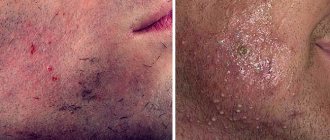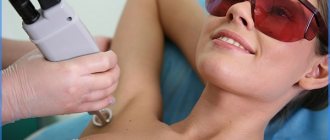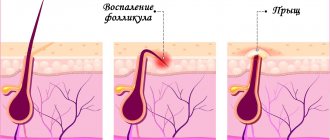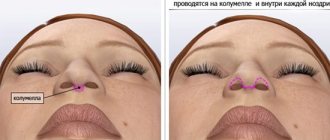Ingrown hairs after waxing are a common problem that girls face after using waxes. Ingrown hairs after hair removal can be prevented if you take all measures aimed at solving this problem. Various methods and means are used against ingrown hairs, for example, peeling, scrub, milk, and even better, go for a consultation with a cosmetologist, since another skin disease may be hidden behind an ingrown hair. Today we will talk about remedies for ingrown hairs after depilation. Read the following article on the pages of the magazine.
Ingrown hair
The consequence of an incorrectly carried out procedure for removing hair from the skin (shaving, depilation or epilation) is hairs ingrown under the top layer of the skin. This is not only an aesthetically unpleasant moment in the post-epilation period, but also threatens the appearance of pustules, ulcers and hyperpigmented scars.
The consequence of an incorrectly carried out procedure for removing hair from the skin is hairs ingrown under the top layer of the skin.
The growing hair follows the simplest path of least resistance and bends, which leads to its improper growth, namely, when removing hair by depilation (or shaving), the upper layer of the epidermis is damaged, resulting in the formation of a micro-wound on the surface of the skin. Over time, the wound heals, and natural restoration of the epidermis occurs on its surface.
The hair, whose growth is activated, is looking for a way out, but the too hard and dense layer of the epidermis does not allow it to “break through”, which is why it continues to grow not in the vertical direction, but horizontally. The reasons may be individual characteristics of the skin (dense epidermal layer of skin), hormonal changes, synthetic underwear, under which the skin does not breathe and sweats.
Preventive actions
To prevent hair from growing into the epidermal layer after removal, it is necessary to do certain preparations:
- 2-3 days before the procedure, you should scrub those areas of the skin where hair will be removed. This should be done by first steaming the skin - taking a hot bath or shower. After using the scrub, apply moisturizer to the skin;
- to prevent hairs from growing in, they are shaved off only after applying a special gel or foam to facilitate the movement of the machine blades over the surface of the skin;
- shaving hair in the direction against its growth is prohibited - this increases the risk of damaging the structure of the hair canal;
- after this process is completed, aftershave cream must be applied to the skin, the effect of which is aimed at softening and moisturizing the epidermis;
- 2 times a week it is necessary to do cosmetic procedures to smooth the surface of the skin and remove dead cell structures. The use of peelings helps to achieve a positive result;
- If hairs have grown in after a certain type of hair removal, it cannot be done again. This also concerns the issue of the permissibility of using an epilator - when ingrown hairs appear after its use, it is necessary to choose another method for removing excess hair;
- Every day it is necessary to apply a cream to the skin of the body - either moisturizing or against ingrown hairs. Cosmetologists do not recommend using greasy cream - the product should be easily absorbed into the skin.
If hair has grown into the epidermal layer more than once after removal, the person should consult a dermatologist. The doctor will help determine the cause of ingrown hairs, if there is evidence, he will prescribe an examination and tell you what to do to prevent disturbances in their growth.
Following the rules of preparation for removing excess hair from the surface of the skin helps prevent the appearance of ingrown hairs. Read more about how to get rid of ingrown hairs by following the link. Regular use of moisturizing cosmetics, selected individually according to your skin type, is also of great importance.
Against ingrown hairs
To remove ingrown hairs, it is recommended to use special gels and under no circumstances use a scrub, especially if pustular formations appear on the skin. In such situations, it is worth using Chlorhexidine 2 times a day.
If there are a lot of pustules on the skin, do not self-medicate
If there are a lot of pustules on the skin, do not self-medicate! Ingrown hairs can easily be confused with a skin condition such as herpes. If severe inflammation occurs, it is better to consult a dermatovenerologist: only a qualified doctor can correctly diagnose the problem.
When home treatment for ingrown hairs after depilation does not bring results, you should make an appointment at a cosmetology clinic, whose specialists will be able to choose the best solution to the problem.
It is recommended against ox ingrowth:
- do light peeling to remove dead cells from the surface of the skin before direct hair removal;
- using moisturizer, lotion, skin milk (but not oil), as well as special products that slow down hair growth;
- do regular peeling (2 times a week) to cleanse pores using a salt scrub that has an antiseptic effect;
- treat delicate areas of the skin with chlorhexidine or salicylic acid solution to prevent inflammation.
Why does hair grow ingrown after hair removal?
Even ardent supporters of natural beauty strive to get rid of unwanted hair. Especially in the summer, when you want to feel perfect not only in a light dress, but also in a seductive bikini on the beach. Smooth skin pleases, if not for one “but”. A few weeks after hair removal, bumps may appear under which ingrown hairs “hide.” They are accompanied by inflammation, redness or, in extreme cases, look very unsightly.
Why does hair grow ingrown after hair removal? Many representatives of the fair sex suffer from this disease. What is the reason? There are many reasons, these could be:
dense layers of the epidermis;
if you have coarse dark hair;
improper hair removal;
Constantly wearing synthetic underwear that is very tight or tight. It does not remove natural vapors from the skin well and can lead to bacterial infections. You should not wear such underwear immediately after hair removal, as this will promote inflammation of ingrown hairs;
insufficient skin care (before and after epilation)
And today I want to talk a little about skin care before and after hair removal.
The day before the procedure (and in the future, preferably once a week), you need to thoroughly steam the skin, it is better to take a bath (with salt, bombs, pralines), after the bath, wash the skin well using a special scrub and a hard jute washcloth. This helps to cleanse the skin well, remove dead cells, which create an extra layer of epidermis and prevent proper hair growth. Before the procedure itself, you also need to take a shower using a scrub with a degreasing effect. This will remove the top flakes of the skin, cleanse it and at the same time lift the hairs, which will make hair removal much easier.
After epilation, treat the skin with a soft scrub (for the bikini area), (for the legs and arms) to free the hair canal from remaining particles of wax or sugar paste, and also sprinkle the skin with lotion against ingrown hairs. Regular use of lotion will help you get smooth skin for a longer period of time. It is advisable to wear cotton underwear immediately after the procedure. Use a scrub and a hard washcloth on an ongoing basis at least 2 times a week to cleanse the skin of dead cells, thereby facilitating proper hair growth. Inhibitor lotion and inhibitor cream that slow down hair growth are also essential for smooth and beautiful legs.
Ingrown hair epilation
The process of ingrown hair depends on the density of the epidermis, that is, on the number of layers of scales. If there are many of them, then it is difficult for a thin growing hair to break through to the surface of the skin, and it chooses the path of least resistance, bending and taking not a vertical, but a horizontal position.
People with dark skin develop ingrown hairs after hair removal more often than people with light skin. This is due to the fact that dark and coarse hairs grow more intensively than light and thin ones. Solving the problem on your own can only worsen the condition of the skin, so to treat ingrown hairs after depilation, you need to contact a professional cosmetologist.
If there is no inflammation and the hairs are located shallow, it is enough to steam the skin and then do a light gentle peeling
Hair prevention after hair removal
If there is no inflammation and the hairs are located shallowly, it is enough to steam the skin and then do a light, gentle peeling. Sometimes, instead of a scrub, a not very hard washcloth or a special mitten made of synthetic material is used. After the procedure, the skin is softened with lotion or moisturizer.
The deep location of the hairs can be immediately noticed by slight redness and thickening of the skin. In such cases, you cannot do without the help of tweezers and a medical needle. The specialist steams the area where hair grows in after depilation with a warm, damp compress, and disinfects the surface with an antiseptic.
Then, use a sterile needle to pry up the hair and remove it with tweezers. The treated area is once again treated with an antiseptic, and a cooling compress is applied to it. If inflammation is present, it is recommended to apply an anti-acne product for several days before going to the cosmetologist.
The best ways to eliminate ingrown hairs
Before considering this issue, you should remember that doing this without the help of a specialist is not recommended.
In order to remove ingrown hairs once and for all, it is necessary not only to remove them mechanically, but also to follow all preventive measures. Excess hair can be removed only when there is no inflammation in the area of the ingrown hair. First of all, you need to steam the skin, then do a light peeling with a scrub. If this is not the case, you can use a hard washcloth.
It happens that even after such an operation the hairs are released. Even if exfoliation fails to eliminate ingrown hairs, it will make the process easier. After ingrown hairs, rather after eliminating them, you need to apply a moisturizer or nourisher to the skin.
The problem area of the skin can be treated with special products. As a rule, in such cases, acne ointments are used. This remedy can remove inflammation. If the inflammation goes away, you can do the same peeling, which will completely eliminate the ingrown hair.
There are cases when the hair has grown too deep, and no method other than mechanical can help. To eliminate ingrown hair mechanically, you must have tweezers and a medical needle. Use a needle to pry up the ingrown hair and pull it out with tweezers. It should be remembered that this is very dangerous, and for your own safety it is necessary to treat the skin area with an antiseptic both before and after the procedure.
Ingrown hairs after epilation
Ingrown hairs after epilation cause a lot of discomfort. If epilation is carried out incorrectly, the hair changes the direction of its growth and, as a result, cannot grow out from under the skin. Ingrowth can be superficial or deep.
In the first case, there is no severe inflammation, and after treatment the hair pustule breaks out on its own. In the second, a fairly large compaction is formed. After it dries, a crust appears, but the bristles remain invisible, and surgical intervention is often required.
If precautions have not helped prevent ingrown hairs, then you need to help them break out. If you have ingrown hairs, it is not recommended to use fatty oils to moisturize the skin. There are several methods available to every woman, using which you can eliminate the problem of ingrown hairs after hair removal.
There are several methods available to every woman that can be used to eliminate the problem of ingrown hairs after hair removal.
Using salicylic acid against ingrown hairs
It has different release forms, is affordable, and has a pronounced antiseptic effect. Therefore, if irritation appears at the site of an ingrown hair, you need to lubricate it three times a day and after a few days the redness will go away.
Using a sterile needle against ingrown hairs
Using a needle, you can remove the ingrown hair from under the skin. The needle should be taken not from a sewing needle, but from a medical one, which is opened immediately before use. After the procedure it is thrown away. One needle cannot open different wounds, one hair - one needle. This is done in order to avoid infection.
Using a hard washcloth against ingrown hairs
If the hair is not very ingrown and only causes itching, then you can take a hard washcloth and walk over it. This will lift the ends of the hairs and give them proper growth.
Often, when an ingrowth occurs, purulent pimples form that need to be opened; to do this, you need to wash your hands, disinfect the area with chlorhexidine and open the abscess. We wipe off the resulting exudate with a cotton pad, also pre-treated with a chlorhexidine solution, and lubricate it with an antiseptic or healing ointment.
How should you deal with ingrown hairs?
What to do if hair grows ingrown after hair removal procedure? Of course they should be removed. However, you need to know how to do it correctly so as not to provoke other problems.
So, the problem of ingrown hair can be dealt with using the following methods:
- If they are shallow and there are no signs of inflammation, you should steam the skin and then peel using a scrub. If you don’t have a scrub, you can use a hard washcloth or a special synthetic glove. If this method does not completely release all the vegetation, it will make it much easier for it to grow outward. The peeling procedure can be carried out daily, after which the skin can be lubricated with some moisturizing cream or lotion. In addition, after epilation, you can lubricate the problem area of the skin with a product that prevents ingrown hairs.
- If inflammation appears at the site of the ingrowth, you should lubricate the area with an anti-acne product for several days. After eliminating signs of inflammation, peeling can be done.
- If the hairs are deep under the skin, a characteristic thickening will be noticeable at the site of ingrowth, as well as redness of the skin. In this case, you should use a mechanical removal method, which experts do not recommend doing yourself. It is better to contact a specialist to solve the problem.
If you do not have this opportunity, then the site of inflammation should be steamed with a warm, damp compress and then treated with an antiseptic. After this, you should pick up the ingrown hair with a sterile needle and remove it with tweezers. After removal, treat the skin area with an antiseptic and apply a cool compress.
To solve the problem of ingrown hairs, lotions using calendula, chamomile, and other plants are used. A warm compress made from a decoction of herbs should be applied to the problem area after hair removal and held for several minutes. This procedure should be repeated for several days in a row. To avoid stains or other problems at the ingrown site, you need to take care of the problem area.
If a tubercle filled with yellow content appears at the site of the ingrown hair, it needs to be squeezed out. Before the procedure, you should treat the tubercle and the skin around it with alcohol. Your hands must be clean, as squeezing can lead to infection.
To squeeze out the contents of the abscess, press it with your fingers. An ingrown hair may also be squeezed out along with the pus. If this does not happen, then the hair should be carefully pulled out. After the procedure, the area on the skin should be re-treated with alcohol.
Ingrown hair remedy
Cosmetic and pharmaceutical brands produce a wide range of products against ingrown hairs in various price categories.
Anti-ingrown hair lotion Depilflax
The lotion is suitable for all skin types, including problematic and sensitive. The active ingredient is salicylic acid. It gently exfoliates the top layer, making the cover very soft. Thanks to this, the hair grows in the right direction and easily penetrates to the top.
Anti-ingrown hair lotion with lemon Aravia Professional
The lotion prevents the formation of ingrown hairs after depilation, soothes and relieves irritation. It has a mild disinfectant property, so it does not cause dryness and flaking. The product is suitable for any skin type and all areas of the body. It does not contain synthetic fragrances, sulfates, alcohol, or parabens.
Cosmetic and pharmaceutical brands produce a wide range of products against ingrown hairs in various price categories
Cristaline Anti-Ingrown Hair Gel for Delicate Areas
The gel prevents ingrown hairs and is an excellent after-depilation care product. The gel texture slightly cools, tones, and relieves all painful symptoms. If there are already inflammatory formations, then the remedy will eliminate swelling and speed up the healing of small pustules and large dense boils. Using the product leads to the restoration of natural internal processes and a clear improvement in appearance. The cover looks healthy, smooth, uniform in color.
Anti-ingrown hair product Waxellent GARDENS Irisk Professional
The domestic brand uses plant extracts and oils that are collected in the most environmentally friendly regions of the country. Constant use leads to smoothing of the skin, improving the internal and external condition of the skin. The increased concentration of active components enhances metabolic processes and normalizes hydro-lipid balance. Buyers gave the Irisk Professional product high marks for efficiency, economical consumption, and ease of use.
Sources:
- https://elenis.com.ua/polezno/114-vrastanie-voloso
- https://depilux.ru/stati/vrastayut-volosy-posle-depilyatsii.html
- https://expertology.ru/15-luchshikh-sredstv-protiv-vrosshikh-volos/
- https://v-kurse.ru/news/health/problema_vrosshikh_volos_posle_epilyatsii_8835990/
Post Views: 41











